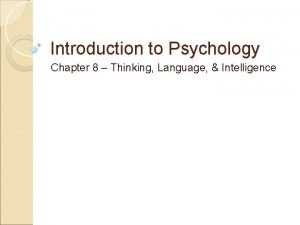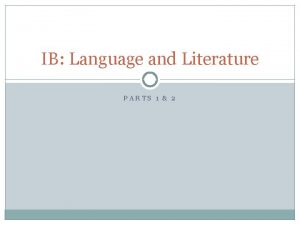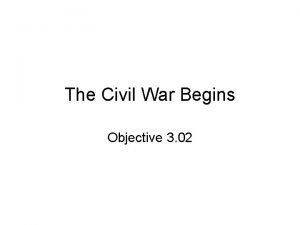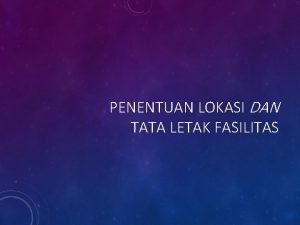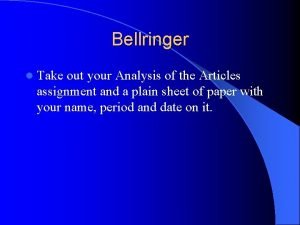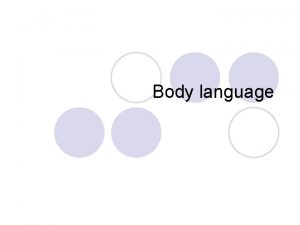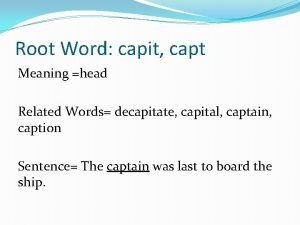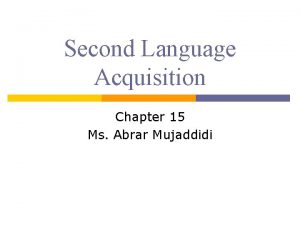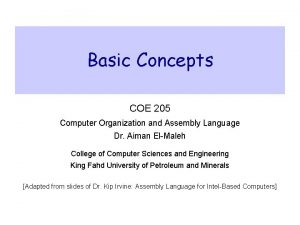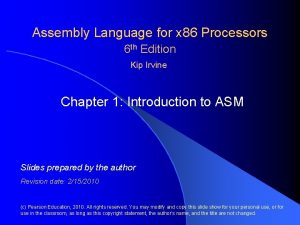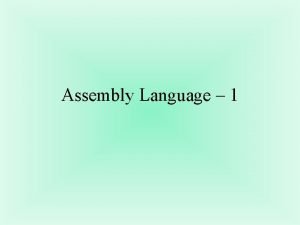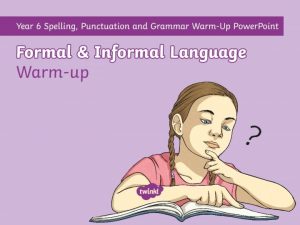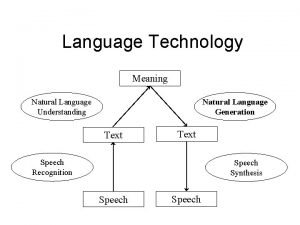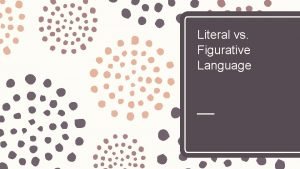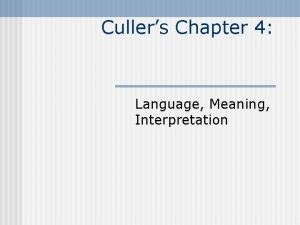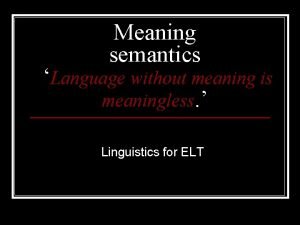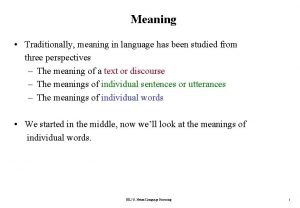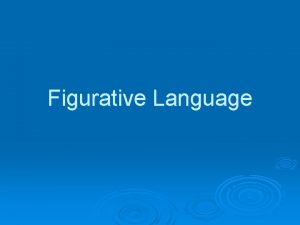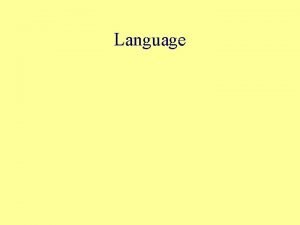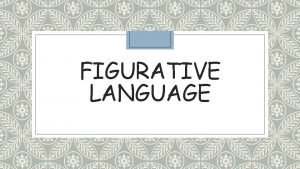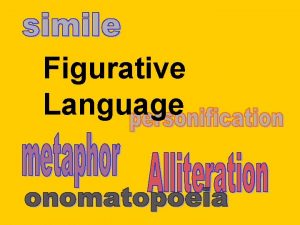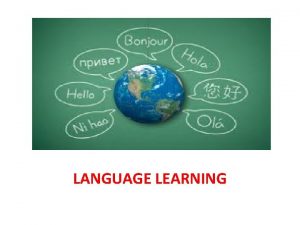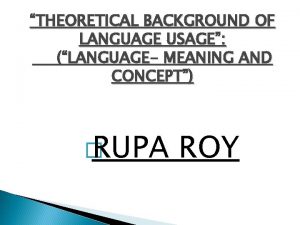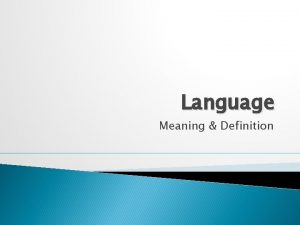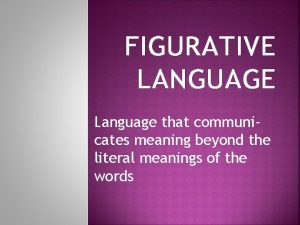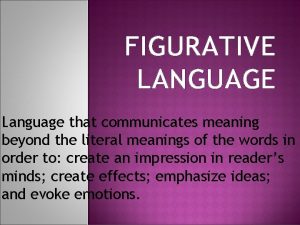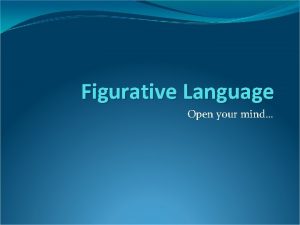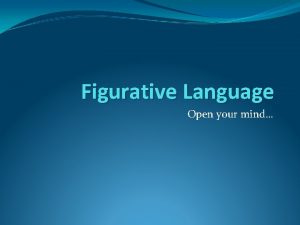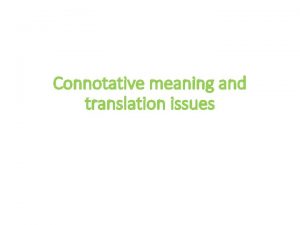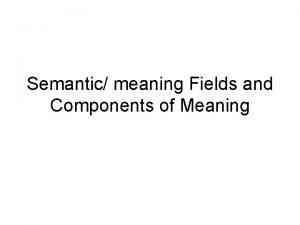Meaning and Language Part 1 Plan We will


























- Slides: 26

Meaning and Language Part 1

Plan • We will talk about two different types of meaning, corresponding to two different types of objects: – Lexical Semantics: Roughly, the meaning of individual words – Compositional Semantics: How larger objects (clauses, sentences) come to mean what they do. Relatedly, how formal logic can be used as a tool to study language • However: These two fit together, as discussed in the reading (Partee) • That is, aspects of what we want to say about what words mean will interact with what we say about larger structures • Today: – Some distinctions – Basic sets and truth conditions – Working towards logic for language

Some Initial Points • Remember that for (content) words like cat, tree, horse, etc. there is an arbitrary connection between sound form and meaning:

Sound and Meaning • This pairing of sound and meaning is one component of language – “arbitrary” component: stressed by de Saussure – “predictable” component: logic, etc. • Rock bottom: basic connections in small units (morphemes, words) between sound and meaning • The full range of things that we associate with human language is found only when such connections are part of a generative system for creating larger units from smaller ones, i. e. the syntax (remember last week)

Outline • Traditional distinctions for sound/meaning connections (homophony, polysemy) • Words and sets (as in set theory) • Basic cases (nouns and adjectives) • Wednesday: Using formal logic to model meaning relations in language

Some Distinctions • First: cases in which the “one to one” mapping between sound forms and meanings is not so direct. – Homophony: A cases in which two words have the same sound form, but distinct and unrelated meanings • Bank-1 ‘side of a river’ • Bank-2 ‘financial institution’

Representation • In any case, with homophony we are dealing with distinct words; that is: – Bank-1 is to Bank-2 as cat is to dog or bank-1 is to cat • This is equivalent to saying that in such cases, the identity in sound form is an accident • In other cases of the same sound form but differing meaning, this is not the case

Polysemy • We speak of polysemy ‘many meanings’ in cases in which we have the same word but with distinct yet related senses; one case: – Pool: water on the ground – Pool: swimming pool • In this case, there is no need to say that there are different words; perhaps really different senses of the same word

Polysemy, cont. • Sometimes with polysemy the intuition is that the word is basically ‘vague’, and that its fuller meanings are supplied by context • Something similar is found with verbs, where the context comes from the syntactic structure: – The whistle sirened lunch time. – The police car sirened the speeder to a stop. • Cases like this indicate that the basic meaning of words can be augmented with information from the syntactic structure – John shinned the ball. – Mary shinned the ball to John. – Etc. • The “core”meaning of the word shin or siren exists, but is augmented by what happens in the syntactic structure

Words and Sets • Let’s take an example of how we think of word meanings… • More interesting: how meanings of combinations of words are derived • We can think of the meaning of some words as relating to a system of categories, some more general, some more specific • This lends itself to representation in terms of sets • A set is, for our purposes, an abstract collection

Examples • Consider the relationship between dog and mammal: – All dogs are mammals. (true) mammals dogs

Examples, cont. • The set relationship is one of inclusion; the set denoted by dog is a subset of the set denoted by mammal • Other relationships are possible as well, both in terms of ‘some’ and ‘no’ • We will formalize an extension to this in the next lecture

‘Some’ and overlapping • It is not true that all snakes are poisonous: – All snakes are poisonous. (false) • But some are: – Some snakes are poisonous. (true) • In cases like this, the set denoted by snake and the set denoted by poisonous overlap: snakes Poisonous things

Non-overlapping: ‘No’ • It can also be the case that sets do not overlap, in addition to overlapping in very small ways • Consider the following: – No mammals are poisonous. • Ok, we want to know what no means, but is this a good example (is it true)?

As far as I know… • As far as I know, the statement ‘No mammals are poisonous’ is false • The duck-billed platypus has a kind of poisonous thing on its leg

Sets • So we need another example of sets that don’t overlap – No dogs are reptiles. (true) dogs reptiles

Truth Conditions • One way of approaching meanings is to look at the truth conditions of sentences • The truth conditions specify in precise terms the circumstances that obtain in order for a sentence to be true (or false) • Specifying the truth conditions is a necessary component of the study of meaning; if we can show that two sentences are true under different conditions, then we would like to say that they have different meanings

Some examples • Sometimes it seems like the specification of truth conditions is trivial: – The cat is on the mat. – The dog is on the mat. – Different truth conditions • But what about more complex cases? Consider: – The glass is half full. – The glass is half empty.

The ‘Glass’ Example • On the face of it, ‘half full’ and ‘half empty’ seem to have the same truth conditions. • But: Consider the following examples: – The glass is almost half full. (e. g. 48%) – The glass is almost half empty. (e. g. 53%) • These have different truth conditions – Assuming that ‘almost’ is the same in the two sentences, it must be the case that ‘half full’ and ‘half empty’ actually have different meanings – If these two phrases were not different in meaning, where else could the difference come from? ?

Other fractions • As a further point, consider what happens when we replace ‘half’ by other fractions: – The glass is three eighths full. – The glass is three eighths empty. • These do not mean the same thing • It looks as if ‘half full’ and ‘half empty’ mean different things, but sometimes can be true under the same circumstances

More on Adjectives • Some further cases from the study of adjectives illustrate – The relevance of our use of sets above – The interaction of lexical meaning with compositional meaning • Let’s take another simple example: – poisonous snake

Interpreting poisonous snake • One way of thinking of the adjective meaning with respect to the noun follows on what we were doing above • What we would like are some general rules that tell us how to interpret certain syntactic objects in terms of the semantics we are using • Rule (informal): When an adjective A modifies a noun N ([A N]), the interpretation of this object is the set defined by the intersection of A’s meaning with N’s meaning

On the interpretation, cont. • This is just like the rule we saw above: snakes Poisonous things • With poisonous snake, we are indicating a member of the overlap between two sets • This can be indicated in a logical notation as well

Some notation • We need a notation for sets and their interaction – || X || = the set of things denoted by property X • Example: || red || = the set of red things • This can also be written as {x| x is red}, read as ‘the set of all things x such that x is red’ – What about how adjectives and nouns combine by the reasoning above? • We need notation for ‘and’; why? Because things that are poisonous snakes are the set of things that are (1) poisonous AND (2) snakes

Putting the pieces together • So, for poisonous snake: – || poisonous || = {x|x is poisonous} – || snake || = {x|x is a snake} – || poisonous snake || = {x| x is poisonous AND x is a snake} • We can also use set notation for this, e. g. : – || poisonous || snake ||

So… • Is it always so simple? Consider: – Reasoning 1: • Larry is a poisonous snake • Larry is a chess player. • Therefore: Larry is a poisonous chess player (valid…but this is more complicated than it looks) – Reasoning 2: • Larry is a skillful artist. • Larry is a chess player • Therefore: Larry is a skillful chess player. (invalid!!)
 Part part whole addition
Part part whole addition Part to part ratio definition
Part to part ratio definition Brainpop ratios
Brainpop ratios Define technical description
Define technical description What are the parts of bar
What are the parts of bar The part of a shadow surrounding the darkest part
The part of a shadow surrounding the darkest part Part to part variation
Part to part variation Thinking, language, memory, and reasoning are all part of
Thinking, language, memory, and reasoning are all part of Ib english language and literature part 3
Ib english language and literature part 3 William tecumseh sherman total war
William tecumseh sherman total war Part plan
Part plan Polk's war plan
Polk's war plan Short, medium and long term planning in education
Short, medium and long term planning in education Example of micro teaching lesson plan
Example of micro teaching lesson plan Layout venue
Layout venue Virginia plan and new jersey plan venn diagram
Virginia plan and new jersey plan venn diagram Body language is universal true or false
Body language is universal true or false Lindalino
Lindalino The part can never be well unless the whole is well
The part can never be well unless the whole is well Words with cide root
Words with cide root Acquisition vs learning
Acquisition vs learning Difference between second language and foreign language
Difference between second language and foreign language Language is
Language is Assembly vs high level language
Assembly vs high level language Difference between assembly language and machine language
Difference between assembly language and machine language Difference between assembly language and machine language
Difference between assembly language and machine language Difference between formal and informal email
Difference between formal and informal email







